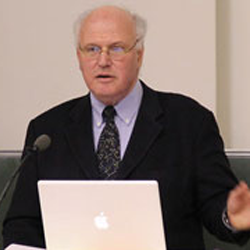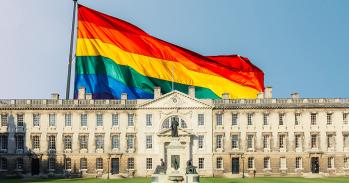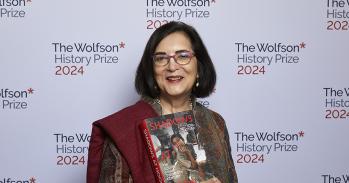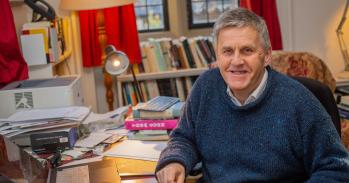
Almost 100 years after the outbreak of World War I, public opinion about war in many of the countries that fought appears to have shifted completely. Historian Jay Winter explains how poetry, art and film have been crucial to that process of transformation.
Almost 100 years after the outbreak of World War I, public opinion about war in many of the countries that fought appears to have shifted completely. Historian Jay Winter explains how poetry, art and film have been crucial to that process of transformation.
The shift of the last 100 years has been one in which writers, artists and filmmakers have provided prisms through which attitudes to war have changed dramatically.
Jay Winter.
Within two months of the outbreak of World War I, as many as 640,000 young men had volunteered for service in the British army. They gathered outside recruiting offices in crowds so large that mounted police sometimes had to be called in to control them. Fast forward 90 years, however, and we find a British Prime Minister apparently lying to the same nation in order to convince it of the moral and legal justification for invading Iraq. Almost a century after the “war to end all wars” failed to do so, popular opinion about warfare has transformed, from a stance of naïve patriotic fervour, to one of widespread aversion or near-abhorrence.
How did we get here? What does it mean? Preparing for a visiting Professorship at Cambridge which aims to address such questions, Jay Winter stumbled across a work of art that seems to embody some of the answers. Anself Kiefer’s Sprache der Vögel (“Language of the Birds”, or, “Birdsong”), is an angel-like sculpture, loaded, like much of Kiefer’s work, with symbols of the Holocaust and of Germany’s dark, Nazi past.
Winter perceived a connection with another, earlier image: Paul Klee’s similarly war-themed Angelus Novus (1920). Created in the aftermath of World War I, this depicts the angel of history, unable to close its wings in its role as humanity’s “guardian angel” and consigned instead to witnessing the events taking place around it. Kiefer’s work, however, goes further. In “Birdsong”, the angel no longer has a face at all; instead, it has been replaced by a stack of burnt books. Following the scale of the atrocities committed during the Holocaust, Winter argues, artists often felt unable to attach a human face to their depictions of a war that had sought to erase entire peoples, gassing and slaughtering millions until their faces disappeared into an empty void.
Cultural references such as this litter a series of three public lectures that Winter commenced last week as part of his Humanitas Visiting Professorship in War Studies, a post which is being hosted by the University of Cambridge’s Centre for Research in the Arts, Social Sciences and Humanities (CRASSH). Touching in turn on literature, painting, lithographs, installation art and film, the lectures are a prelude to a book Winter will write exploring the way terror has a history and so do artistic representations of it since 1914. Even when soldier-artists reflected on their experience, the work they produced shows that war is necessarily mediated for us by conventions and symbolic forms of the time. Over the last 100 years, the contribution of writers, artists and filmmakers to our understanding of war has been more influential in both reflecting and forming public attitudes to war and violence.
World War I seems an odd place to start. During the 19th century artists of various descriptions had depicted war through painting and drew on the new possibilities of photography and reportage. Dispatches from the front line in the Crimea, sent to The Times by the pioneering war correspondent, William Russell, not only broke boundaries in journalism but outraged the British public faster than the Government could mould their opinions. A decade later, shocking photographs taken on the battlefields of the American Civil War exposed the horrors of a fully industrialised conflict, which introduced principles such as “total war” and trench-based fighting.
Both, Winter suggests, were nevertheless dwarfed by the scale and trauma of the assembly-line slaughter that occurred during 1914-18; a cataclysm which, he argues “democratised suffering” and transformed the meaning of war itself.
Cultural mediations of war followed suit. “The shift of the last 100 years has been one in which writers, artists and filmmakers have provided prisms through which attitudes to war have changed dramatically, not everywhere, but in Western and Central Europe to be sure,” Winter says. “They have played a key role in giving form and voice to the view that war is an exercise in futility, without redeeming features. We have moved away from ideas about glory in war, and as a result, we have moved beyond war itself.”
 The notion that glory and war were intimately connected before 1914, but have grown ever further apart since, is core to Winter’s views about war literature and, in particular, war poetry. He argues that because each language carries its own set of idioms, meanings, and connotations, the combatants of World War I spoke many different languages of war. In France, for example, notions of “la gloire” have deep, patriotic connections with the revolutionary era of 1789 to 1848, and also with Catholicism, which is rich in imagery associating glory with death. Similarly, the Irish linked glory to a form of “tragic joy”. William Butler Yeats famously criticised the English war poets, commenting that “passive suffering is not the subject of poetry”.
The notion that glory and war were intimately connected before 1914, but have grown ever further apart since, is core to Winter’s views about war literature and, in particular, war poetry. He argues that because each language carries its own set of idioms, meanings, and connotations, the combatants of World War I spoke many different languages of war. In France, for example, notions of “la gloire” have deep, patriotic connections with the revolutionary era of 1789 to 1848, and also with Catholicism, which is rich in imagery associating glory with death. Similarly, the Irish linked glory to a form of “tragic joy”. William Butler Yeats famously criticised the English war poets, commenting that “passive suffering is not the subject of poetry”.
So it was in Britain, Winter believes, that the change began – and with the very poets whom Yeats attacked. Bereft of as recent a revolutionary or Catholic history, he argues that the poets who documented the carnage of the Somme and Passchendaele emerged from a different cultural environment that enabled them to question more directly the “glory” of what they saw. He even thinks that this can be traced in statistical terms – a search through Google’s huge database of 6,000,000 books shows that, in the 1900-1930 period, references to “glory” in British literature incrementally declined, while French references to “la gloire” increased. The pattern is similar for 1900-2000, although the French usage peaks during World War I.
The work of poets like Siegfried Sassoon and Wilfred Owen therefore became a liminal point in the cultural mediation of war, helping the public to understand and conceptualise it with a vocabulary still in use today, as terms like “shell-shock” attest. Winter believes that the war poets became “carriers of memory”, as well as the midwives of this new vision of war as a futile, rather than glorious, thing. In the long run, this has meant that even though they did not write as a coherent movement, they have still been canonised as a group.
“Thousands of poets have written about war, but only in Britain are there War Poets,” he adds. “They are iconic in that they have entered the literary canon and A-level courses on English writing for decades.”
Where the appalling nature of the war in the 20th century extended beyond something that words alone could communicate, however, artists came to the fore. Here, Winter says, the history is one of “effacement”, from Klee’s Angelus Novus to Kiefer’s “Birdsong”; in which the abiding trend saw the human face of war gradually and necessarily, faded away.
Otto Dix, an artist who returned to the trenches after witnessing the brutality of World War I first-hand, painted ghostly, haggard figures walking through apparent landslides of corpses and sometimes bonded, when living, with the entrails of those who were dead. They were, nevertheless, identifiably human. The artists who came afterwards made a contribution that Winter eloquently summarises as “the braiding together of war with terror over the past three generations.” In short, they made it faceless.
This, of course, was because war had become an increasingly faceless process in itself. Rapid technological change over the 20th century repeatedly dehumanised warfare beyond most people’s imaginations, moving from aerial bombing, through multiple genocides, to the threat of nuclear holocaust. Picasso’s Guernica, a response to the bombing of that town by German and Italian planes during the Spanish Civil War, is a landmark in this regard. Compared with Dix, the faces of the victims have begun to fragment and are part of a broken and ruined landscape. Winter also points out the light bulb in the painting, which he suggests is a grimly ironic gesture by the artist; Picasso contributed the work to the Spanish pavilion of 1937 in the Paris world exhibition celebrating scientific innovation.
Even this was only the beginning. As “Birdsong” shows, artists like Kiefer had to respond to the Holocaust – an even more extreme event – in still more extreme ways. As an act, the genocide committed by the Nazis was devoid of any discernible humanising features, so it was a logical step for artists to blankly erase the human face, creating a sort of black void that echoed the obliteration of what had taken place. For Winter, Kiefer’s winged sculpture of burnt books, juxtaposed with Klee’s earlier guardian angel, echoes Heine’s warning: “First they burn books and then they burn people.”
By harnessing both image and sound, film offered new cultural opportunities to imagine and mediate the experience of conflict. Until 1926, however, sound was not available to filmmakers who wanted to bring war to the big screen. This made film no less effective a medium. Arguably, it became more effective still, in that it avoided the illusion that it could actually show the face of war.
Throughout the history of cinema, Winter believes that directors have been forced to take one of two approaches when depicting war – the “spectacular” or the indirect. The spectacular seeks to persuade the audience that they are experiencing the heat of battle. Steven Spielberg’s Saving Private Ryan (1998) is one much-celebrated example. The indirect method shows less of war itself and more of its effects on situations or people. Schindler’s List (1993) – another Spielberg opus – is a case in point here. We never see fighting at the front in World War II during this film, yet few would dispute that it embodies much of what the war was about.
Silent filmmakers, bereft of sound, had to suggest or gesture towards realism. This, Winter thinks, made their contribution all the more powerful. One of the reasons that the British Government’s propaganda piece, The Battle Of The Somme (1916), caused audiences to swoon and cry out when it showed a dead soldier fall back into his trench was, Winter says, because of the “visceral punch” of the silence. And such techniques persisted into the “talkies” age; the first big-screen version of All Quiet On The Western Front (1930) concludes with a long, silent shot of the dead protagonists, looking back at the viewers before they march off into eternity. “The central point about silence is that it carries terror within it much more readily than the scariest script or movie score,” Winter reflects. “Stop the sound and the terror is one of the elements of the story that rushes to the surface.”
Although the advent of sound in cinema opened the floodgates to a spectacular, realist school, Winter believes that the indirect approach has usually worked best. Indirect depictions of war never invite the audience to leave behind the notion that this is just a representation – so they bring them to terms with the bizarre and uncanny nature of war. For decades, films cast from the same mould as mid-century World War II films like The Longest Day (1962) have promised to show audiences “what it was really like”. Box office hits they may have been, but they failed to fulfil that ambition.
Winter cites exponents of the indirect approach as the high-water marks of 20th century war movie-making. They include the Japanese work, Burmese Harp (1956), the French film Forbidden Games (1952), but most of all Jean Renoir’s Grande Illusion (1937) – which will be shown as part of his visiting Professorship next week. It is, he believes, a class apart: “Grande Illusion said so much about war without showing a single battle scene,” he reflects. “That is indirection as cinematic genius”.
As our ideas about war have become more ambiguous, more directors have opted for the indirect approach. Those depicting World War II in the middle 20th century were, for the most part, at liberty to show a conflict many cinemagoers agreed was one between good and evil. With the era of asymmetric warfare ushered in by Vietnam (as well as the more nuanced contributions of historians of World War II and other conflicts), it has become far more difficult to show war in such terms. The redemption that emerges from later films tends to be about the camaraderie and courage of individuals, and less about the justifiability of the war itself. Conflict itself has been shown, increasingly, to be meaningless and ambiguous in work such as the Vietnam films of Oliver Stone, or in Gulf War movies like Jarhead (2005) and The Hurt Locker (2008).
For Winter, the consequences of this process of cultural evolution are clear. “I do think that one reason Tony Blair lied about weapons of mass destruction was because he couldn’t take the nation with him in support of war,” he considers. “That is a consequence of the contribution artists, poets, filmmakers and others have made to our understanding of the horrors of war.”
“Only a fool would argue that cultural history only moves in one direction at any given time. Nevertheless, there is clearly something that has brought most people to the view that war is simply not a legitimate human activity any more. Time and again culture has shown us that the best defence we have against the ravages of war is the human imagination itself.”
Jay Winter’s Humanitas Visiting Professorship was made possible by the support of Sir Ronald Grierson and the Institute for Strategic Dialogue.
This work is licensed under a Creative Commons Licence. If you use this content on your site please link back to this page.





